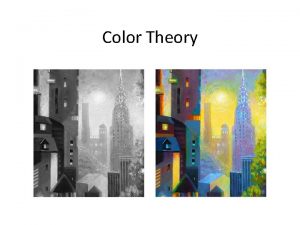Chapter 4 Color Color Theory p 82 The





- Slides: 5

Chapter 4 Color- Color Theory p. 82 The Standard Color Wheel Theory (Palette Theory, Prang Theory, David Brewster Color Theory) Based on a conventional color circle or wheel where three primary hues, red, yellow and blue are placed equidistant. Secondary hues are placed between the primaries Result of mixing equal parts of two of them Ex. Red and yellow equal orange Intermediate (tertiary hue) is created by mixing a primary and a secondary color together Ex. Yellow plus orange equals yellow-orange

Chapter 4 Color- Color Theory Standard Color Wheel theory Continued… • Mixing the colors on the wheel with black and white yields an unlimited number of colors (hence the name palette theory). Warm colors- colors related to red Cool colors- colors related to blue Chevreul discovered through his studies that color combinations can be divided into analogous and contrasting harmonies Monochromatic color schemes- based on one color (Figure 4. 4) Analogous color schemes- colors adjacent to each other on the color wheel (Figure 4. 5) Complimentary colors- are those opposite each other on the color wheel) Direct complimentary Split complements Double compliments Tetrad compliments Alternate compliment

Chapter 4 Color- Color Theory The Munsell Theory A major color theory in general use for Interior Design today Albert H. Munsell- An American colorist, who published the book, Color Notation, which is still in use today. A precise, formula based system for notating specific colors Munsell formulated a color wheel and then expanded it into a three-dimensional globe with leaves or pages of color variations.

Chapter 4 Color- Color Theory The Munsell Theory continued: he Munsell system is based on three attributes that determine exact color identity. Hue, the color name Hue families are given a letter and a numerical notation, 2. 5, 5, 7. 5, and 10, 5 is the pure hue Value, the lightness or darkness of a hue White is designated as 10 black is designated at 0 Every color has what is termed a normal value, see table 4. 1, which means that every hue has a certain value level as it occurs naturally or in its most natural appearing state Chroma or Intensity, the amount of pure chroma in a given hue; the relative brightness vs. the dullness The numbers are ranged from 1 -16. Lower numbers are neutralized or dulled by adding its color wheel compliment The higher numbers indicate less of that complementary color, so the color becomes clearer and purer, and sometimes brighter as the number increases. Yellow is very light and has the lightest natural saturation point, and violet is the darkest

Chapter 4 Color- Color Theory Other Color Theories Wilhelm Ostwald-Ostwald Theory, plotted as triangular paged with hues not varied by chroma, but by the amount of black and white. Johannes Itten-a teacher at Bauhaus in Germany, did comprehensive cork in color theory. Published two famous works: The Art of Color and The Elements of Color. Josef Albers-a teacher at Bauhaus and Yale, became famous for his studies in simultaneous and successive contrast. He authored: Interaction of Color









